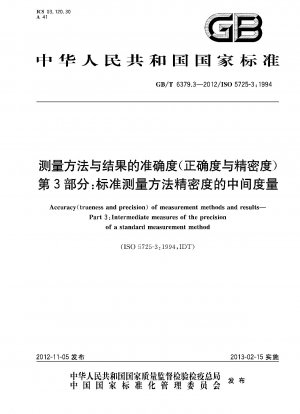GB/T 6379.3-2012
Accuracy(trueness and precision) of measurement methods and results.Part 3:Intermediate measures of the precision of a standard measurement method (English Version)
- Standard No.
- GB/T 6379.3-2012
- Language
- Chinese, Available in English version
- Release Date
- 2012
- Published By
- General Administration of Quality Supervision, Inspection and Quarantine of the People‘s Republic of China
- Latest
- GB/T 6379.3-2012
- Scope
- This standard specifies four measures of intermediate precision due to variations in observational conditions (time, calibration, operator, and equipment) within the laboratory. These intermediate measures can be produced in a defined intra-laboratory test or through inter-laboratory tests. In addition, this part of GB/T 6379: a) discusses the meaning of the definition of the intermediate precision measure; b) provides guidance for the interpretation and application of the estimation of the intermediate precision measure in practical work; c) does not provide guidance for estimating the intermediate precision measure Error provides any measure; d) does not involve how to determine the correctness of the measurement method itself, but discusses the relationship between the correctness and the measurement conditions. 1.2 This section applies to the measurement methods involved, specifically referring to the measurement of continuous quantities, and each measurement takes only one value as the measurement result, although this value may be the calculation result of a set of observations. 1.3 The essence of determining these measures of intermediate precision is the quantitative expression of the ability of a measurement method to repeat the results of a test under specified conditions. 1.4 The statistical methods described in this section are based on the premise that information from "similar" measurement conditions can be combined to obtain more accurate information on intermediate precision measures. This premise is valid as long as the alleged "similarity" is indeed "similar". However, this premise is difficult to satisfy when estimating intermediate precision measures from interlaboratory studies. For example, in order to make sense of combining information from different laboratories, it is very difficult to make all participating laboratories "similar" by controlling for their "time" effect (effect) or "operator" effect (effect). Therefore, caution should be exercised when using results from interlaboratory studies of intermediate precision. In-laboratory studies also rely on the above premise, but this time the premise is easier to achieve because the analyst knows more about the actual impact of a factor and knows how to control it. 1.5 In addition to the techniques described in this section, there are other techniques for estimating and confirming a measure of intermediate precision within a laboratory, such as control charts (see GB/T 6379.6). This section does not claim to provide the only method for estimating intermediate precision measures within a particular laboratory.
GB/T 6379.3-2012 Referenced Document
- GB/T 3358.1-2009 Statistics-Vocabulary and symbols-Part 1:General statistical terms and terms used in probability
- GB/T 6379.1-2004 Accuracy(trueness and precision)of measurement methods and results Part 1:General principles and definitions
- GB/T 6379.2-2004 Accuracy(trueness and precision)of measurement methods and results-Part 2:Basic method for the determination of repeatability and reproducibility of a standard measurement method
- ISO 3534-1:1993 Statistics; vocabulary and symbols; part 1: probability and general statistical terms
GB/T 6379.3-2012 history
- 2012 GB/T 6379.3-2012 Accuracy(trueness and precision) of measurement methods and results.Part 3:Intermediate measures of the precision of a standard measurement method

GB/T 6379.3-2012 -All Parts
GB/T 6379.1-2004 Accuracy(trueness and precision)of measurement methods and results Part 1:General principles and definitions
GB/T 6379.2-2004 Accuracy(trueness and precision)of measurement methods and results-Part 2:Basic method for the determination of repeatability and reproducibility of a standard measurement method
GB/T 6379.3-2012 Accuracy(trueness and precision) of measurement methods and results.Part 3:Intermediate measures of the precision of a standard measurement method
GB/T 6379.4-2006 Accuracy(trueness and precision) of measurement methods and results-Part 4:Basic methods for the determination of the trueness of a standard measurement method
GB/T 6379.5-2006 Accuracy (trueness and precision)of measurement methods and results-Part 5:alternative methods for the determination of the precision of a standard measurement method
GB/T 6379.6-2009 Accuracy(trueness and precision)of measurement methods and results.Part 6:Use in practice of accuracy values